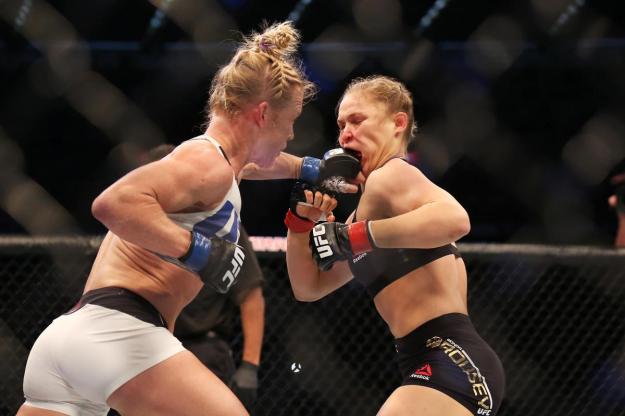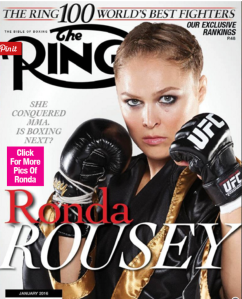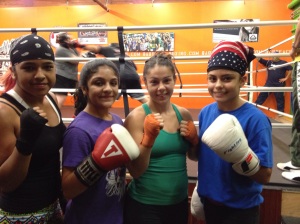Susan Reno is taking on Jolene Blackshear on Sept. 4th, Exclusive Q and A.

With a 1-2-1 record, Susan Melucci Reno seems an unlikely challenger for fighter Jolene Blackshear (8-5, 3-KOs), whose strong punching power, record of quality opponents and titles would seem to be another one of those crazy mismatches.
What Susan Reno brings to the ring, however, is grit, determination and at 41 years of age, perennial youthfulness packed into her compact, dynamic, ever moving body.
Film goers who’ve had the opportunity to watch Jill Morley’s excellent personal documentary entitled, Fight Like A Girl, have also been given the treat to watch Susan in action when she was first starting out as an amateur boxer in the New York Daily News Golden Gloves. Winning the Gloves at thirty-four proved to be just the beginning and as Reno readies to fight Blackshear in what is sure to be an exciting 6-round punch-fest, she is excited not only to have gotten the call, but to meet what she knows will be a fantastic challenge.
Recently, Girlboxing had the chance to meet with Susan Reno and her husband and trainer, Michael Reno in Brooklyn.
Here’s some of what she had to say.
- How did you get into boxing?
I started with Muay Thai first … I thought I was too cool for school and my friend said “Do you want to learn how to kick box?” and I ‘m like “yeah.” So I got into that and then I realized, “hmm” I watched the fighters train, and I though didn’t want to fight, I figured, let me see if I can keep up with the fighting that they did – and I could more than keep up. After that I was in the ring … had about five Thai fights.
Mike and my brother then said, “Would you please switch to boxing. You don’t kick anybody you just punch; you win your fights just punching.” And [Mike] just went ahead and got me a boxing match and as soon I started training for it, ‘cause the rhythm is so different, I loved it and that was it, it was all boxing after that.
- You actually fought and won in the NY Daily News Golden Gloves.
I fought in the 2007 Golden Gloves. I got two fights, and I got to fight at [Madison Square] Garden and I got to call my dad and say, “hey, ah, I’m fighting at the Garden can you make it?” And I was so happy that I got to fight at the Garden. I love what they’re doing at Barclay’s Center, starting new traditions, but for me, a fight at Madison Square was fantastic.

Susan Merlucci Reno in Fight Like A Girl, Photo Credit: Philip Habib
- While you were training for the Gloves, you were in Jill Morley’s film Fight Like A Girl. What was that experience like that for you?
It’s funny. I’m super grateful for the experience because unlike a lot of my fellow boxers, I have footage of everything. I have footage of all my fights, I have footage of all my training. So it’s a little painful to know someone’s following you around with a camera, but on the other hand, I can look back now and am grateful I can look back and see how far I’ve come from that point. It was a good experience.

Susan Reno, in her pro debut, landing a straight right fighting Vanessa Greco. Photo Credit: Staten Island Advance/ Bill Lyons
- What made you decide to go pro? You came to boxing very late. You were thirty-four at the Golden Gloves and thirty-nine when you turned pro.
I am forty-one now and yeah, thirty-four was the cut-off at the Golden Glove. As for turning pro, I was still able to compete and I feel that I don’t have a lot of miles on me. I’m smarter and as I’m getting older – you learn so many cool things, so many new tricks, and as long as I’m learning and I’m moving and I can make that punch miss, I’m still boxing.
I had my first pro fight last January of 2013. I had three fights that year. I fought Vanessa Greco twice and Jackie Park once. The Jacqueline Park fight I learned to fight more than four rounds ’cause I found her. She was tall but I found her in the third round and in the fourth round, I definitely found her. And then the fight was over and I thought I’m not doing four rounds ever again if I can help it. (Note to readers, Susan Reno lost the fight on a split decision.)
My first fight was against Vanessa Greco. It was a feeling of accomplishment. I know she was an accomplished amateur and she has the pro experience, so I knew it was going to be a tough challenge, and I knew she was coming to fight. She’s fought some of my friends, but … I’m not afraid of a challenge … I have nothing to lose. So it’s all experience for me … and it’s not like I’m twenty years old … and I train fighters and more than training fighters, I have so many students, so the experience pays back to them, so whatever I can accumulate for myself, it’s just more that I can give back to my students.
- Promoter Bobby D is putting on the card you’ll be fighting on against Jolene Blackshear on September 4th at the Crowne Plaza Hotel in San Diego.
They’re a very professional group. He puts women’s fights on every card or almost every card. I had my last pro fight on April 4, 2014 out there. Jolene and I were on the same card. We were in the same locker room. Very professional… I respect her a lot. Mike got the call.
Michael Reno: The matchmaker called and asked if Susan was available. We’re ready.
Susan Reno: She’s a two-time world champion. I’m really excited to fight. I know she’s really tough and she’s really strong and she’s really experienced.
We’re fighting six rounds. I’m getting my roadwork in. I’m getting my gym work in. I’m getting my sparring in. I’m eating right, resting … I feel good. It’s almost a little scary, but I feel good.
I know she’s got power. For a little tiny woman she’s got power from what I understand. Big right hand, big left hooks. So I know she’s got a lot of power. She puts her opponents on their butt. It’s a huge challenge, but I feel like we’re going to have a great time in there.

- What tricks do you have up your sleeve?
Stay focused! And focus on being focused. Stay in that moment, you know, not worry about what she may or may not do and just see what’s happening, see what she’s doing, be in the moment. I think that’s probably the most important thing as far as being in the ring whether you’re sparring or fighting, training. When we get back to the student thing for me as a trainer teaching, it’s being in the moment, not worrying about what’s going to happen in the next round, what’s going on outside of the ring, being in the moment.
I love the training. There’s the physical and the mental training. I remember when I first started doing Muay Thai, my head instructor at the time said fighting is just like a chess match, and I was just a crazy ball of energy and I’m like “chess match, what are you talking about chess match?”
And now I’m like, all right, if I do this, then they’re probably going to do this and then I’ll do this, and I see the chess match now, that’s what really excites me, and as far as physical training, I love that I’m strong and I’m fast. I can be explosive, so I feel I keep my body better now then when I was in my twenties, which is one of the reasons I’m glad they extended the age for women’s amateur boxing, because I feel that a lot of women get into this so late and they realize “my gosh, I’m good at this, I can do this,” and then, the cut off age.
- A lot of women in the 20s and 30s didn’t know they could participate in explosive sports. As a trainer, what do you feel you are able to give these women when they come in to train?
I definitely feel that my experience in the ring and preparing to be in the ring, has made me a better person and a better trainer. It’s allowed me to be more patient, more calm, and I realize … some trainers like to yell, some trainers like to slap their students around, get them all riled up and crazy, and I feel that there are so many other things that can be crazy that trying to stay in the moment gives me a calmer point of view when I’m training people.
Someone will do something wrong, but I feel there isn’t really right or wrong, I tell them I have all day and we’ll take as long as it takes to get it right … there’s no consequence right now, no one’s trying to hit you right now … so as I’m talking to them, I feel like it’s given me a lot of patience.
I train women and men … oddly more men. I started in Muay Thai, so there’s a little bit of a martial arts focus, because of the way my Muay Thai trainer brought us up, there’s a respect and a calm and so you have to pay your dues, but most of the people I work with know you’ve got to pay your dues, and I admit I have smart ways … and If you think you’re going to get around this the easy way, I’ve got a trick or two up my sleeve.
- Were you always athletic as a kid?
It’s definitely something I came to … I played basketball oddly enough, all five feet of me … I did a season of cheerleading. I went to Art School at Pratt Institute and moved to Brooklyn. I’m an art school drop out unfortunately, and I was the art kid, I’d paint and draw. And wasn’t particularly athletic, that’s why team sports freaked me out, because people depended on you, but with boxing, it’s you … you have your team, your trainers and so on … but if I get hit it’s my fault.
- How does boxing play into you as an artist?
It’s absolutely art. Watching how punch combinations get put together and physics … now I’m actually looking at it now
My job is geometry and physics …
You know how to throw a jab, how to throw a cross how to roll under a punch … but it’s little things, like timing, your timing and being able to change-up the timing and bring it all back so that it makes sense. And I love the footwork.

Susan Reno, Golden Gloves, 2007. Photo Credit: Fight Like A Girl
10. What do you want to do with this, where are you in five years?
One thing I have learned is stop retiring because after the nationals. I fought Cheryl Houlihan who was the five-time world champion. I’d never been to a world championship, Mike had never been … we get there and we didn’t know what was going on, there were three rings, a cow bell, a bicycle, chaos … so I’m all geared up and I draw the champion first, it’s a computer draw, and I’d had five fights, six fights, something like that, and she’s the five-time champion, and I’m like, I don’t care, I have to fight her sooner or later, let’s go. We had a really good fight. She gave me two standing eights in the first round, but I gave her two standing eights in the third round … and yeah, she beat me, but by three points. After that fight I said, I’m thirty-four, I’m retiring now, but … well, I’m still fighting. As for five years from now? I don’t know. I’ll be in some aspect of boxing whether I’m fighting or just training people, I’ll definitely be in boxing. And, I earn my living in boxing. I train people. I’m at The Wat, a Muay Thai gym. I teach boxing, Muay Thai and conditioning, mostly as a personal trainer.
11. You’re training young female athletes too. What changes are you seeing in the women’s boxing amateur scene?
They’re getting better! You see some of these kids at 16, they’re fantastic. They’ve got skills. You can see what’s coming for 2020 … They are definitely as good as the boys. The coaches are taking them seriously too.
12. Having been to the USA Boxing Nationals in 2007, what is it like to see these kids now?
It’s fantastic. You’re seeing them with the same skill levels as the boys. They’re slipping; they’re making things miss; setting things up. They’re explosive. It’s not just two people lobbing punches at each other. It’s exciting.
13. On the pro scene you’re getting a fantastic opportunity to fight Jolene. Where do you see women’s boxing going on the pro side?
I’m in a unique position where I’m comfortable taking chances, and coming into somebody’s home town, and I know that they’re the favorite, that they’re supposed to win, but I’m comfortable with going in there and giving it my absolute best, and guess what, I might upset some people that night. That’s the plan. Being older you’re more confident. What are you going to do, shoot me? I’ll take the bullet out and then I’ll beat you.

Susan Reno with husband and trainer Michael Reno. Photo credit: Malissa Smith
14. And what about for female boxers in general?
I feel it’s a little tougher … I have a job. I’m a trainer. I’m doing this because I love it. I’m not trying to earn my purse. It’s definitely tough for some of these women. They’re trying to earn a living and compete with what the professional men get. It is absolutely frustrating. But it’s got to get better. The quality is going up. It’s got to get better.
Michael Reno: You need a network to take a chance. Then you need a fighter to take a chance and not take a big purse because the network isn’t going to want to pay. And finding a quality fighter to fight her.











































